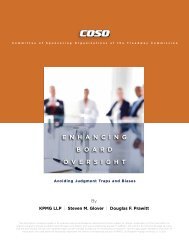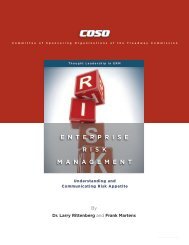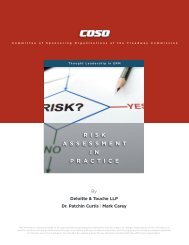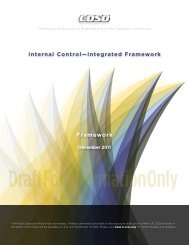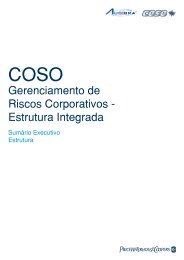Embracing Enterprise Risk Management: Practical - Coso
Embracing Enterprise Risk Management: Practical - Coso
Embracing Enterprise Risk Management: Practical - Coso
Create successful ePaper yourself
Turn your PDF publications into a flip-book with our unique Google optimized e-Paper software.
Thought Leadership in ERM | <strong>Embracing</strong> <strong>Enterprise</strong> <strong>Risk</strong> <strong>Management</strong>: <strong>Practical</strong> Approaches for Getting Started | 3<br />
Although it makes sense to build upon existing risk related<br />
activities, it must be done with the recognition that the<br />
existing activities probably do not constitute ERM. ERM<br />
requires risk management processes that ultimately are<br />
applied across the enterprise and represent an entity-wide<br />
portfolio view of risk, which is often missing from these<br />
existing functions.<br />
Theme 6.<br />
Embed ERM into the business<br />
Fabric of the Organization<br />
As articulated in COSO’s ERM definition, enterprise risk<br />
management is a process that is applied across the<br />
organization. It is a management process, ultimately owned<br />
by the chief executive officer and involves people at every<br />
level of the organization. The comprehensive nature of the<br />
ERM process and its pervasiveness across the organization<br />
and its people provides the basis for its effectiveness.<br />
ERM cannot be viewed or implemented as a stand-alone<br />
staff function or unit outside of the organization’s core<br />
business processes. In some companies and industries,<br />
such as large banks, it is common to see a dedicated<br />
enterprise risk management unit to support the overall ERM<br />
effort including establishing ERM policies and practices for<br />
their business units. However, because ERM is a process,<br />
ii. initial Action Steps and Objectives<br />
Building off the “Keys to Success,” this section of the<br />
thought paper details an initial action plan and steps to<br />
support development of a tailored ERM initiative. The<br />
plan reflects some simple, basic steps for implementing<br />
ERM, including the key step of performing an initial risk<br />
assessment. In Appendix B – “Where to Start: Draft<br />
Action Plan for an ERM Initiative” – we have included an<br />
example action plan, which can be further adapted for use<br />
by organizations. And in Appendix C – “Frequently Asked<br />
ERM Questions” – we have included responses to some<br />
common questions related to ERM that directors and senior<br />
management should find useful.<br />
Step 1.<br />
Seek board and Senior <strong>Management</strong><br />
Leadership, involvement and Oversight<br />
The board of directors and senior management set the<br />
tone for the organization’s risk culture. Their involvement,<br />
leadership and oversight are essential for the success of<br />
any ERM effort.<br />
organizations may or may not decide that they need<br />
dedicated, stand-alone support for their ERM activities.<br />
Whether a risk management unit exists or not, a key to<br />
success is linking or embedding the ERM process into its<br />
core business processes and structures of the organization.<br />
Some organizations, for example, have expanded their<br />
strategic plans and budgeting processes to include the<br />
identification and discussion of the risks related to their<br />
plans and budgets.<br />
Theme 7.<br />
Provide Ongoing ERM Updates and Continuing<br />
Education for Directors and Senior <strong>Management</strong><br />
ERM practices, processes and information continue<br />
to evolve. Thus, it is important for directors and senior<br />
executives to ensure that they are receiving appropriate<br />
updates, new releases and continuing education on ERM,<br />
including information about regulatory requirements and<br />
best practices. This information provides the opportunity<br />
for directors and senior management to update their risk<br />
management processes as they become aware of new or<br />
developing practices. This ongoing improvement process is<br />
particularly important with the increased focus on ERM by<br />
regulators, rating agencies, and the SEC.<br />
A recent COSO thought paper, Effective <strong>Enterprise</strong> <strong>Risk</strong><br />
<strong>Management</strong>: The Role of the Board of Directors, notes that;<br />
“An entity’s board of directors plays a critical role<br />
in overseeing an enterprise-wide approach to risk<br />
management. Because management is accountable to the<br />
board of directors, the board’s focus on effective oversight<br />
is critical to setting the tone and culture towards effective<br />
risk management through strategy setting, formulating<br />
high level objectives, and approving broad-based resource<br />
allocations.” 1<br />
The board and senior management should agree on their<br />
initial objectives regarding ERM, its benefits and their<br />
expectations for successful ERM. At a high level, there<br />
should be clear agreement and alignment of the board’s and<br />
senior management’s expectations, timing and expected<br />
results. This should include agreement on the resources to<br />
be made available and targets dates for the effort. The board<br />
should also consider the timing and level of status reporting<br />
that will be required to effectively monitor and oversee the<br />
ERM effort.<br />
1 Download COSO’s Effective <strong>Enterprise</strong> <strong>Risk</strong> <strong>Management</strong>: The Role of the Board of Directors thought<br />
paper from COSO’s website (www.coso.org).<br />
w w w . c o s o . o r g




